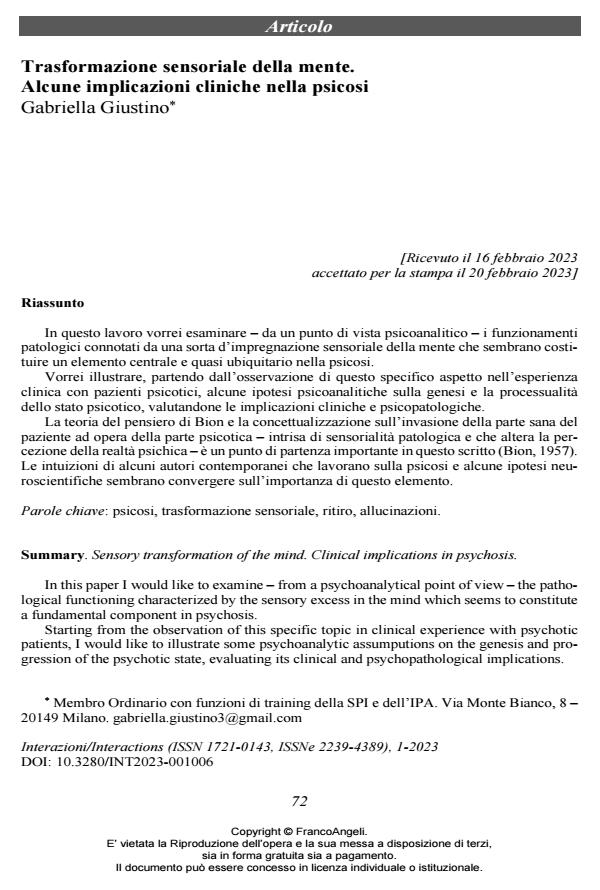Sensory transformation of the mind. Clinical implications in psychosis
Journal title INTERAZIONI
Author/s Gabriella Giustino
Publishing Year 2023 Issue 2023/1
Language Italian Pages 12 P. 72-83 File size 163 KB
DOI 10.3280/INT2023-001006
DOI is like a bar code for intellectual property: to have more infomation
click here
Below, you can see the article first page
If you want to buy this article in PDF format, you can do it, following the instructions to buy download credits

FrancoAngeli is member of Publishers International Linking Association, Inc (PILA), a not-for-profit association which run the CrossRef service enabling links to and from online scholarly content.
In this paper I would like to examine ‒ from a psychoanalytical point of view ‒ the patho-logical functioning characterized by the sensory excess in the mind which seems to constitute a fundamental component in psychosis. Starting from the observation of this specific topic in clinical experience with psychotic pa-tients, I would like to illustrate some psychoanalytic assumputions on the genesis and progres-sion of the psychotic state, evaluating its clinical and psychopathological implications. Bion’s theory of thought and conceptualization on the invasion of the healthy part of the patient by the psychotic part ‒ imbued with pathological sensoriality and which transforms the perception of psychic reality ‒ is a main point in this paper (Bion, 1957). Some contemporary authors ideas on psychosis and neuroscientific evidence seems to converge on the significance of this subject.
Keywords: psychosis, sensory transformation, retreat, hallucination.
- Allen P., Larøi F., McGuire P., Aleman A. (2008). The hallucinating brain: A review of structural and functional neuroimaging studies of hallucinations. Neuroscience & Biobehavioral Reviews, 32, 1: 175-191.
- Aulagnier P. (1985). Hallucinatory withdrawal. Is it the same thing as autistic withdrawal? In Lefer J. (2011), Reading french psychoanalisis. New York: Routledge, 2009.
- Aulagnier P. (1975). La violenza dell’interpretazione. Roma: Borla, 1987.
- Bergman P., Escalona S.K. (1949). Unusual sensitivities in very young children. The Psychoanalytic Study of the Child, 3, 1: 333-352. DOI: 10.1080/00797308.1947.1182309
- Bion W.R. (1957). Criteri differenziali tra personalità psicotica e non psicotica. In Bion W.R., Analisi degli schizofrenici e metodo psicoanalitico. Roma: Armando, 1979.
- Bion W.R. (1962). Apprendere dall’esperienza. Roma: Armando, 1972.
- Bion W.R. (1963). Gli elementi della psicoanalisi. Roma: Armando, 1973.
- Bion W.R. (1965). Trasformazioni. Il passaggio dall’apprendimento alla crescita. Roma: Armando.
- Bion W.R. (1967). Analisi degli schizofrenici e metodo psicoanalitico. Roma: Armando, 1979.
- Cattelan C. (2022). Il lavoro congiunto madre-bambino in situazioni di grave rischio evolutivo. Rivista di Psicoanalisi, 68: 811-827.
- Correale A. (2021). La potenza delle immagini. Milano: Mimesis.
- De Masi F., Davalli C., Giustino G., Pergami A. (2015). Hallucinations in the psychotic state: psychoanalysis and the neurosciences compared. International Journal of Psycho-Analysis, 96, 2: 293-318. DOI: 10.1111/1745-8315.1223
- De Masi F. (2018). Svelare l’enigma della psicosi. Fondamenti per una terapia analitica. Milano: Mimesis.
- Edelman G.M., Tononi G. (2000). A universe of consciousness how matter becomes imagination. New York: Basic Book. [Trad. it. Un universo di coscienza. Come la materia diventa immaginazione. Torino: Einaudi].
- Freud S. (1915). L’inconscio. OSF, vol 8. Torino: Bollati Boringhieri, 1976.
- Gaddini E. (1959). La ruminazione nell’infanzia. In Gaddini E., Scritti 1953-1985. Milano: Raffaello Cortina, 1989.
- Giustino G. (2009). Memory in dreams. International Journal of Psycho-Analysis, 90, 5: 1057-1073.
- Giustino G. (2017). Further developments of the concept of fantasy. International Journal of Psycho-Analysis, 98, 3: 831-839. DOI: 10.1111/1745-8315.1258
- Khan M. (1976). The changing use of dreams in psychoanalytic practice-in search of dreaming experience. International Journal of Psycho-Analysis, 57, 3: 325-330.
- Lombardi R. (2016). Psicosi e Dissociazione corpo-mente. Una prospettiva personale sulla psicoanalisi delle crisi acute e della schizofrenia. In Lombardi R., Rinaldi L., Thanopulos S. (a cura di), Psicoanalisi delle psicosi. Prospettive attuali. Milano: Raffaello Cortina.
- Nicolò A.M., Giustino G., Vigna-Taglianti M. (a cura di) (2022). La mente sensoriale e lo spettro allucinatorio. Risonanze tra psicoanalisi e neuroscienze. Milano: FrancoAngeli.
- Northoff G., Qin P. (2011). How can the brain’s resting state activity generate hallucinations? A “resting state hypothesis” of auditory verbal hallucinations. Schizophrenia Research, 127, 1-3: 202-214.
- Schore A. (1994) Affect regulation and the origin of self. Hillsdale, NJ: Lawrence Elbaum.
- Tustin F. (1986). Barriere autistiche nei pazienti nevrotici. Roma: Borla.
- Williams P. (2010). L’autorità della tenerezza. Milano: Mimesis, 2022
Gabriella Giustino, Trasformazione sensoriale della mente. Alcune implicazioni cliniche nella psicosi in "INTERAZIONI" 1/2023, pp 72-83, DOI: 10.3280/INT2023-001006